
Royal Botanic Gardens, Kew is a non-departmental public body in the United Kingdom sponsored by the Department for Environment, Food and Rural Affairs. An internationally important botanical research and education institution, it employs 1,100 staff. Its board of trustees is chaired by Dame Amelia Fawcett.

The Cyperaceae are a family of graminoid (grass-like), monocotyledonous flowering plants known as sedges. The family is large, with some 5,500 known species described in about 90 genera, the largest being the "true sedges" genus Carex with over 2,000 species.
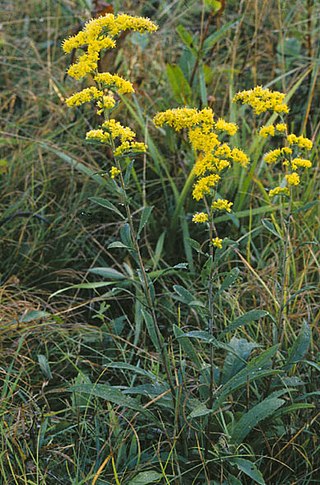
Goldenrod is a common name for many species of flowering plants in the sunflower family, Asteraceae, commonly in reference to the genus Solidago.

Joseph Marie Henry Alfred Perrier de la Bâthie was a French botanist who specialized in the plants of Madagascar.
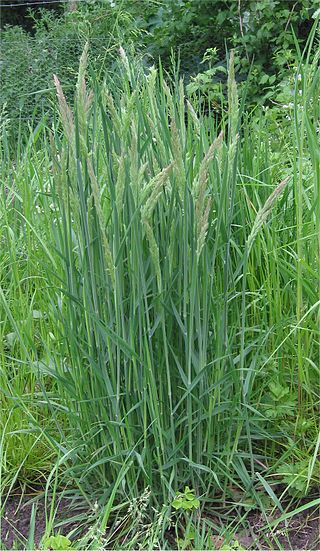
Holcus lanatus is a perennial grass. The specific epithet lanatus is Latin for 'woolly' which describes the plant's hairy texture. Common names include Yorkshire fog, tufted grass, and meadow soft grass. In North America, where it is an invasive species, names include velvet grass and common velvet grass.
William Botting Hemsley was an English botanist and 1909 Victoria Medal of Honour recipient.
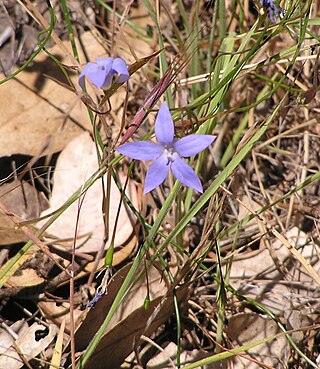
Wahlenbergia is a genus of around 260 species of flowering plants in the family Campanulaceae. Plants in this genus are perennial or annual herbs with simple leaves and blue to purple bell-shaped flowers, usually with five petals lobes. Species of Wahlenbergia are found on all continents except North America, and on some isolated islands, but the greatest diversity occurs in the Southern Hemisphere.
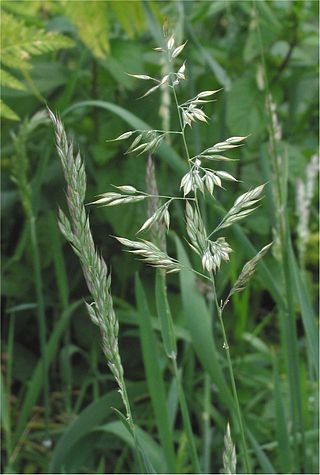
Holcus is a genus of African and Eurasian plants in the oat tribe within the grass family.
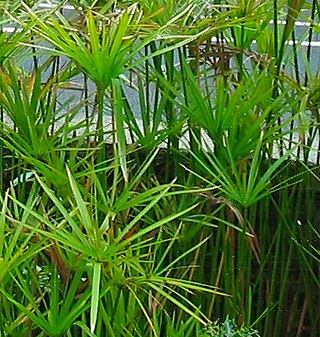
Cyperus alternifolius, the umbrella papyrus, umbrella sedge or umbrella palm, is a grass-like plant in the very large genus Cyperus of the sedge family Cyperaceae. The plant is native to West Africa, Madagascar and the Arabian Peninsula, but widely distributed throughout the world. It has gained the Royal Horticultural Society's Award of Garden Merit. The subspecies Cyperus alternifolius ssp. flabelliformis is also known as Cyperus involucratusRottb..

Deschampsia cespitosa, commonly known as tufted hairgrass or tussock grass, is a perennial tufted plant in the grass family Poaceae. Distribution of this species is widespread including the eastern and western coasts of North America, parts of South America, Eurasia and Australia.

Erigeron annuus, the annual fleabane, daisy fleabane, or eastern daisy fleabane, is a species of herbaceous, annual or biennial flowering plant in the family Asteraceae.

Caesia is a genus of herbs in the family Asphodelaceae, subfamily Hemerocallidoideae, native to Australia, New Guinea, Madagascar and Southern Africa. The mostly 3-lobed seed capsules contain rounded black seeds. The genus was named in honour of Federico Cesi (1585-1630), an Italian scientist.

Anisopogon is a genus of Australian plants in the grass family. The only known species is Anisopogon avenaceus, native to Victoria and New South Wales. It is known commonly as oat speargrass. It is a perennial grass growing up to 1.5 metres tall, bearing spikelets up to 6 centimetres long.

Symphyotrichum pilosum is a perennial, herbaceous, flowering plant in the Asteraceae family native to central and eastern North America. It is commonly called hairy white oldfield aster, frost aster, white heath aster, heath aster, hairy aster, common old field aster, old field aster, or steelweed. It may reach 20 to 120 centimeters tall, and its flowers have white ray florets and yellow disk florets.

Kew Gardens is a botanic garden in southwest London that houses the "largest and most diverse botanical and mycological collections in the world". Founded in 1840, from the exotic garden at Kew Park, its living collections include some of the 27,000 taxa curated by Royal Botanic Gardens, Kew, while the herbarium, one of the largest in the world, has over 8.5 million preserved plant and fungal specimens. The library contains more than 750,000 volumes, and the illustrations collection contains more than 175,000 prints and drawings of plants. It is one of London's top tourist attractions and is a World Heritage Site.
The World Checklist of Selected Plant Families is an "international collaborative programme that provides the latest peer reviewed and published opinions on the accepted scientific names and synonyms of selected plant families." Maintained by the Royal Botanic Gardens, Kew, it is available online, allowing searches for the names of families, genera and species, as well as the ability to create checklists.
GrassBase is a web-based database of grasses, continually maintained and updated by the Royal Botanic Gardens, Kew.
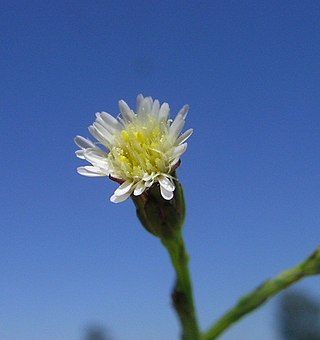
Symphyotrichum subulatum, commonly known as eastern annual saltmarsh aster or, in Britain and Ireland where it is naturalized, annual saltmarsh aster, is an annual plant in the family Asteraceae native to the eastern United States and the Gulf Coast to Texas. The species grows primarily in coastal salt marshes, although in the Ozarks it occurs as a non-marine weedy variety.

Maria Sergeevna Vorontsova is a Russian-born botanist, specializing in the taxonomy of Poaceae (grasses). She was responsible for authoring the taxon for Solanum agnewiorum and Solanum umtuma. She is a member of the Accelerated Taxonomy department at Royal Botanic Gardens, Kew. She is one of the co-authors and maintainers of GrassBase, and is an editor of the journal, Phytotaxa.
Poa fax is a species of grass in the family Poaceae, native to the Australian states of Western Australia, South Australia, New South Wales, and Victoria. This species has the shortest scientific name of any plant. Poa is Greek for "fodder", and fax is Latin for "torch" or "flame", referring to "its dense, spike-like inflorescence which resembles a torch with ascending tongues of flame". While the name Poa fax is accepted as valid by Flora of Australia, and some databases reflect this, such as POWO, WCSP and FloraBase, other sources such as Tropicos, WFO and GrassBase consider it a synonym of Neuropoa fax.















